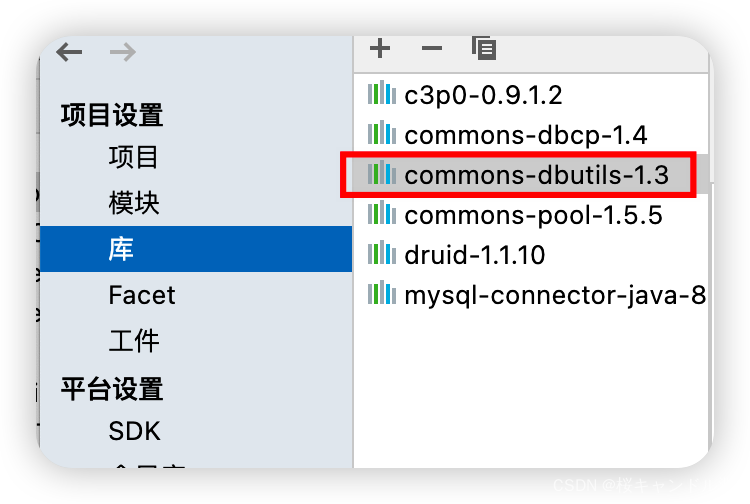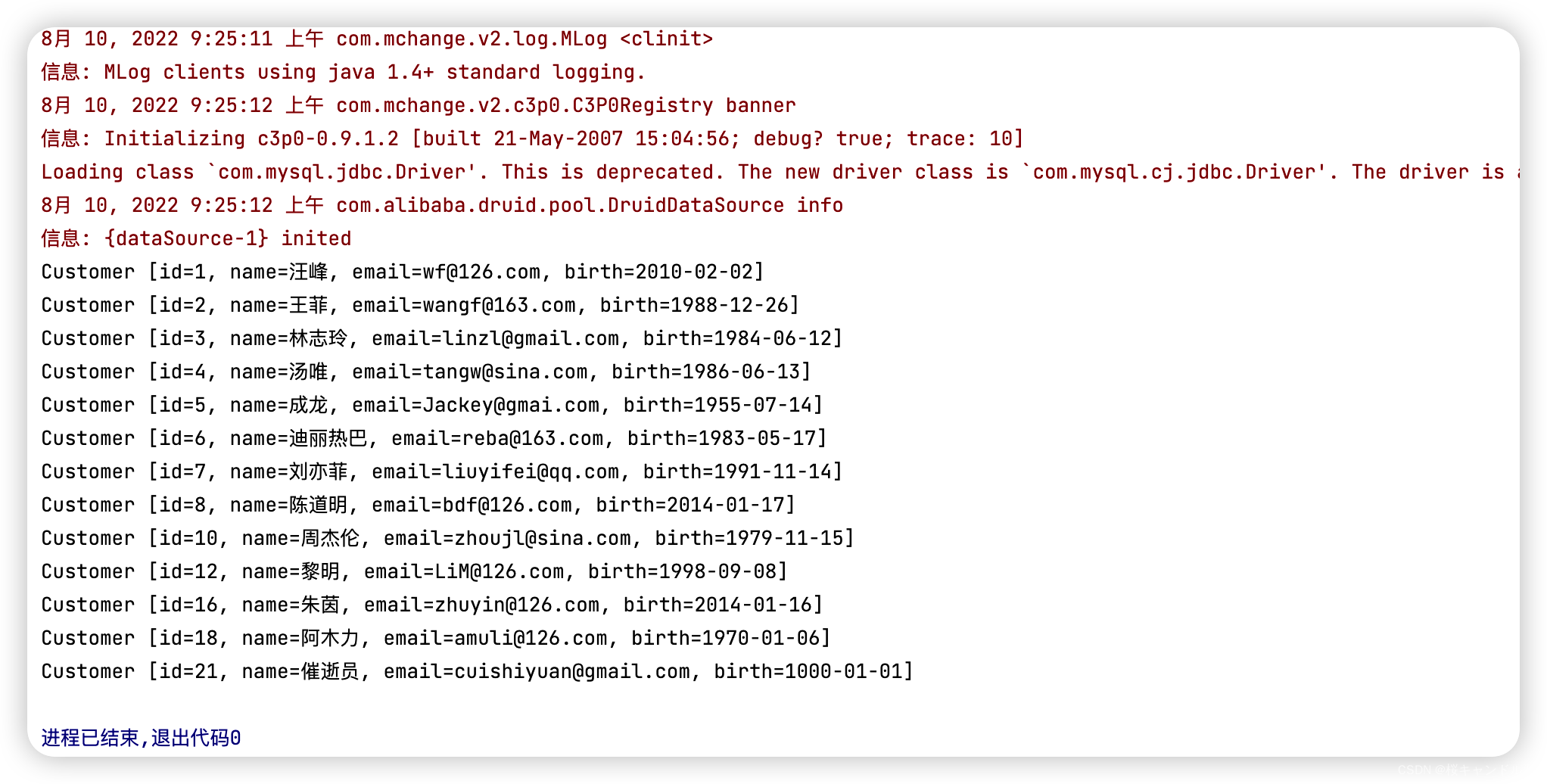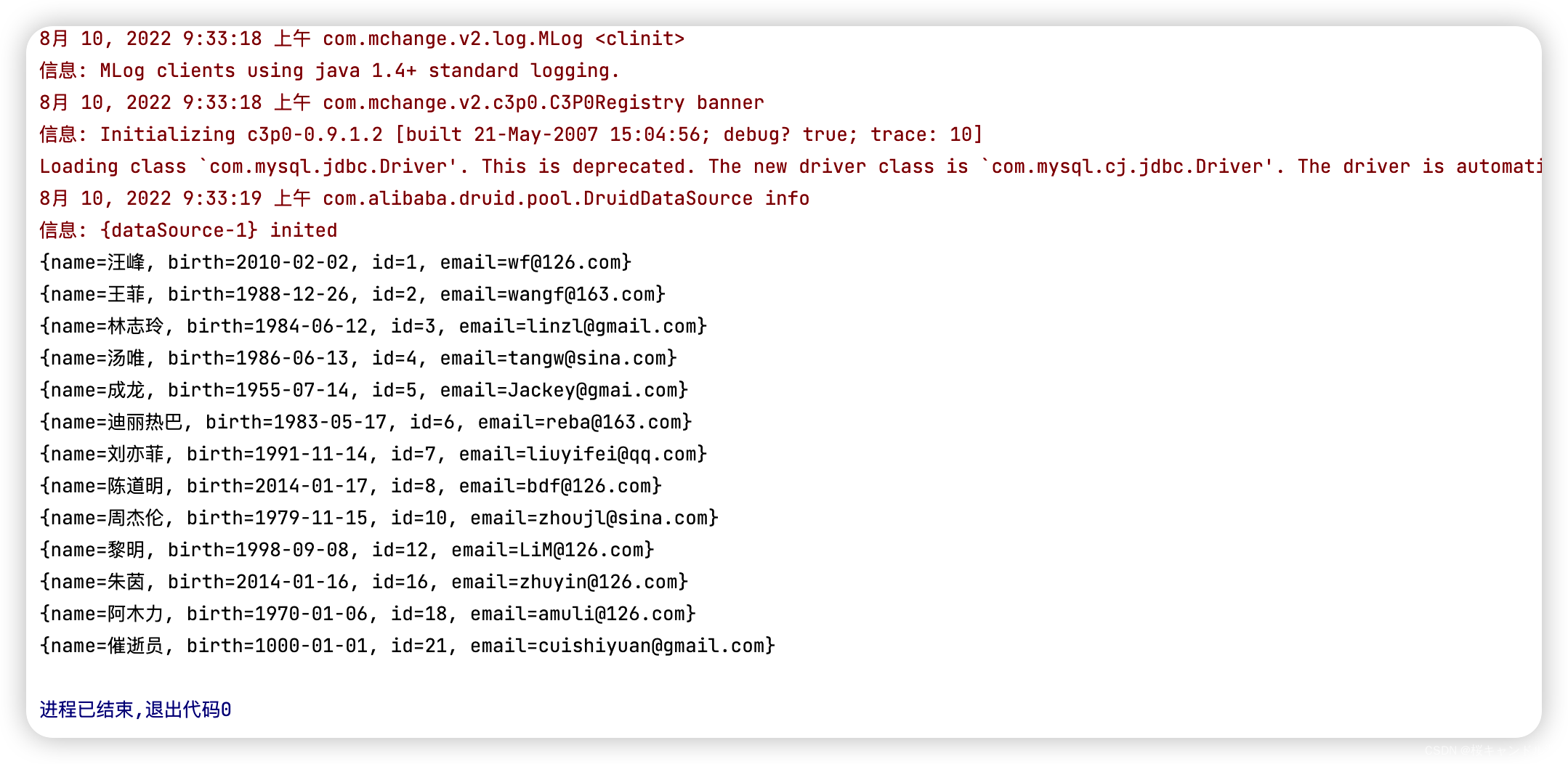目录
commons-dbutils 是 Apache 组织提供的一个开源 JDBC工具类库,封装了针对于数据库的增删改查操作
首先导入我们所需要的Dbutils的jar包

一、测试插入
//测试插入
@Test
public void testInsert() {
Connection conn = null;
try {
QueryRunner runner = new QueryRunner();
conn = JDBCUtils.getConnection3();
String sql = "insert into customers(name,email,birth)values(?,?,?)";
//返回值是添加了几条记录
int insertCount = runner.update(conn, sql, "薛总司令","siling@126.com","1997-09-08");
System.out.println("添加了" + insertCount + "条记录");
} catch (SQLException e) {
e.printStackTrace();
}finally{
JDBCUtils.closeResource(conn, null);
}
}

二、测试查询
查询单条记录
//测试查询
/*
* BeanHander:是ResultSetHandler接口的实现类,用于封装表中的一条记录。
*/
@Test
public void testQuery1(){
Connection conn = null;
try {
QueryRunner runner = new QueryRunner();
conn = JDBCUtils.getConnection3();
String sql = "select id,name,email,birth from customers where id = ?";
BeanHandler<Customer> handler = new BeanHandler<>(Customer.class);
Customer customer = runner.query(conn, sql, handler, 23);
System.out.println(customer);
} catch (SQLException e) {
// TODO Auto-generated catch block
e.printStackTrace();
}finally{
JDBCUtils.closeResource(conn, null);
}
}
查询多条记录
/*
* BeanListHandler:是ResultSetHandler接口的实现类,用于封装表中的多条记录构成的集合。
*/
@Test
public void testQuery2() {
Connection conn = null;
try {
QueryRunner runner = new QueryRunner();
conn = JDBCUtils.getConnection3();
String sql = "select id,name,email,birth from customers where id < ?";
BeanListHandler<Customer> handler = new BeanListHandler<>(Customer.class);
List<Customer> list = runner.query(conn, sql, handler, 23);
list.forEach(System.out::println);
} catch (SQLException e) {
e.printStackTrace();
}finally{
JDBCUtils.closeResource(conn, null);
}
} 
查询单条记录并且封装为键值
/*
* MapHander:是ResultSetHandler接口的实现类,对应表中的一条记录。
* 将字段及相应字段的值作为map中的key和value
*/
@Test
public void testQuery3(){
Connection conn = null;
try {
QueryRunner runner = new QueryRunner();
conn = JDBCUtils.getConnection3();
String sql = "select id,name,email,birth from customers where id = ?";
MapHandler handler = new MapHandler();
Map<String, Object> map = runner.query(conn, sql, handler, 23);
System.out.println(map);
} catch (SQLException e) {
e.printStackTrace();
}finally{
JDBCUtils.closeResource(conn, null);
}
}
查询多条记录并且封装为键值
/*
* MapListHander:是ResultSetHandler接口的实现类,对应表中的多条记录。
* 将字段及相应字段的值作为map中的key和value。将这些map添加到List中
*/
@Test
public void testQuery4(){
Connection conn = null;
try {
QueryRunner runner = new QueryRunner();
conn = JDBCUtils.getConnection3();
String sql = "select id,name,email,birth from customers where id < ?";
MapListHandler handler = new MapListHandler();
List<Map<String, Object>> list = runner.query(conn, sql, handler, 23);
list.forEach(System.out::println);
} catch (SQLException e) {
e.printStackTrace();
}finally{
JDBCUtils.closeResource(conn, null);
}
}
特殊查询:查询表中记录个数
使用scalarHandler满足特殊查询需求
/*
* ScalarHandler:用于查询特殊值
*/
@Test
public void testQuery5(){
Connection conn = null;
try {
QueryRunner runner = new QueryRunner();
conn = JDBCUtils.getConnection3();
String sql = "select count(*) from customers";
ScalarHandler handler = new ScalarHandler();
Long count = (Long) runner.query(conn, sql, handler);
System.out.println(count);
} catch (SQLException e) {
e.printStackTrace();
}finally{
JDBCUtils.closeResource(conn, null);
}
}
特殊查询:查询最大日期
@Test
public void testQuery6(){
Connection conn = null;
try {
QueryRunner runner = new QueryRunner();
conn = JDBCUtils.getConnection3();
String sql = "select max(birth) from customers";
ScalarHandler handler = new ScalarHandler();
Date maxBirth = (Date) runner.query(conn, sql, handler);
System.out.println(maxBirth);
} catch (SQLException e) {
e.printStackTrace();
}finally{
JDBCUtils.closeResource(conn, null);
}
}
三、自定义resultsethandler的实现类
*
* 自定义ResultSetHandler的实现类
*/
@Test
public void testQuery7(){
Connection conn = null;
try {
QueryRunner runner = new QueryRunner();
conn = JDBCUtils.getConnection3();
String sql = "select id,name,email,birth from customers where id = ?";
//我们自己定义了一个handler并且重写了其中的方法
ResultSetHandler<Customer> handler = new ResultSetHandler<Customer>(){
@Override
public Customer handle(ResultSet rs) throws SQLException {
//其实下面的query的返回值,其实就是我们现在这个当前方法的返回值
// System.out.println("handle");
// return null;
// return new Customer(12, "成龙", "Jacky@126.com", new Date(234324234324L));
if(rs.next()){
int id = rs.getInt("id");
String name = rs.getString("name");
String email = rs.getString("email");
Date birth = rs.getDate("birth");
Customer customer = new Customer(id, name, email, birth);
return customer;
}
return null;
}
};
Customer customer = runner.query(conn, sql, handler,23);
System.out.println(customer);
} catch (SQLException e) {
e.printStackTrace();
}finally{
JDBCUtils.closeResource(conn, null);
}
}
四、关闭连接
之前手动关闭数据库连接池的写法
/**
* 关闭连接和Statement的操作
*/
public static void closeResource(Connection conn,Statement ps){
try {
if(ps != null)
ps.close();
} catch (SQLException e) {
e.printStackTrace();
}
try {
if(conn != null)
conn.close();
} catch (SQLException e) {
e.printStackTrace();
}
}
/**
* 关闭资源操作
*/
public static void closeResource(Connection conn,Statement ps,ResultSet rs){
try {
if(ps != null)
ps.close();
} catch (SQLException e) {
e.printStackTrace();
}
try {
if(conn != null)
conn.close();
} catch (SQLException e) {
e.printStackTrace();
}
try {
if(rs != null)
rs.close();
} catch (SQLException e) {
e.printStackTrace();
}
}使用Dbutils工具类实现资源关闭的写法
/**
* 使用dbutils.jar中提供的DbUtils工具类,实现资源的关闭
*/
public static void closeResource1(Connection conn,Statement ps,ResultSet rs){
//直接关闭
try {
DbUtils.close(conn);
} catch (SQLException e) {
e.printStackTrace();
}
try {
DbUtils.close(ps);
} catch (SQLException e) {
e.printStackTrace();
}
try {
DbUtils.close(rs);
} catch (SQLException e) {
e.printStackTrace();
}
//或者是悄无声息地关闭掉,也就是是将上面的try catch一并封装进去
DbUtils.closeQuietly(conn);
DbUtils.closeQuietly(ps);
DbUtils.closeQuietly(rs);
}

























 147
147











 被折叠的 条评论
为什么被折叠?
被折叠的 条评论
为什么被折叠?










